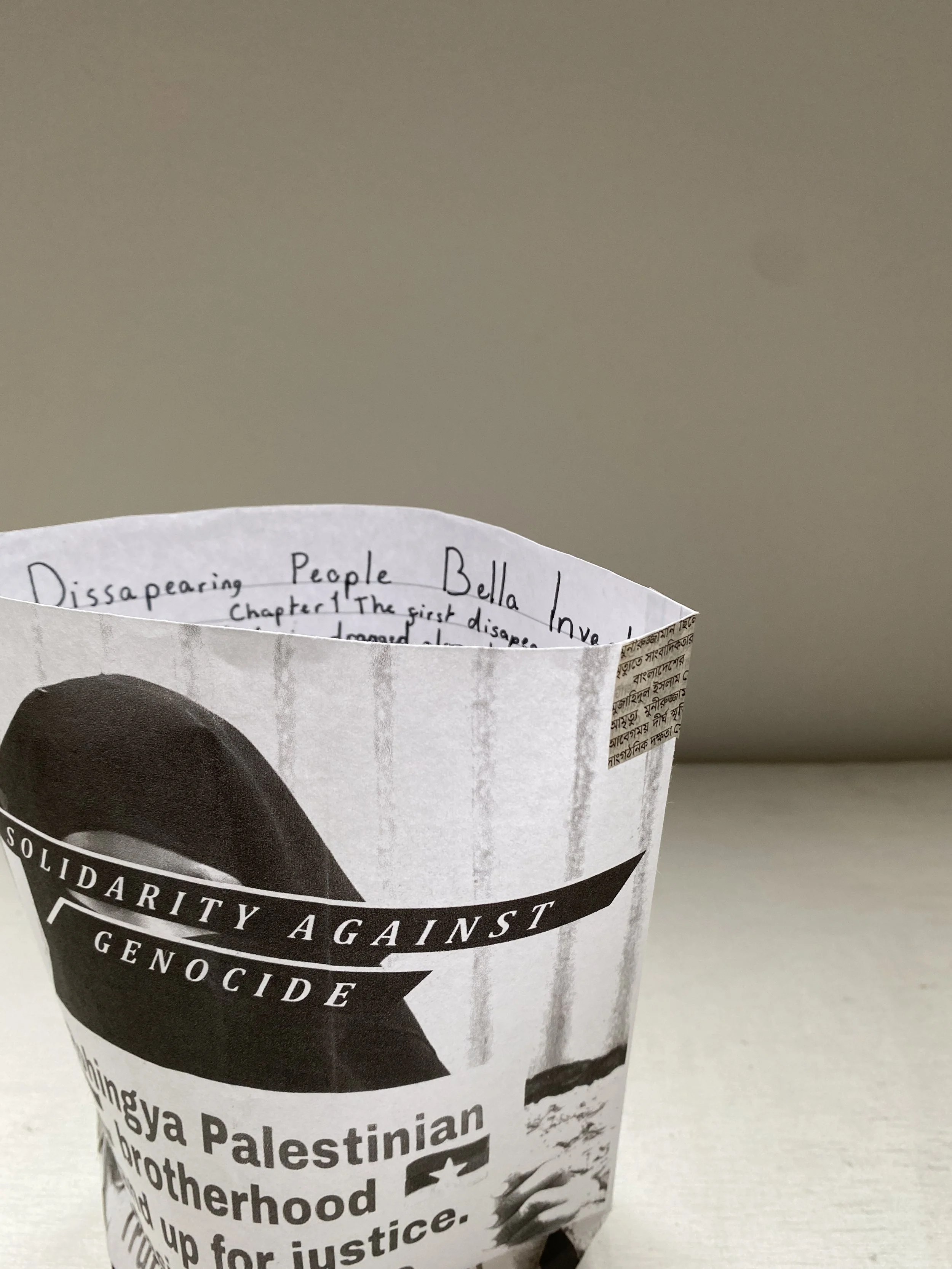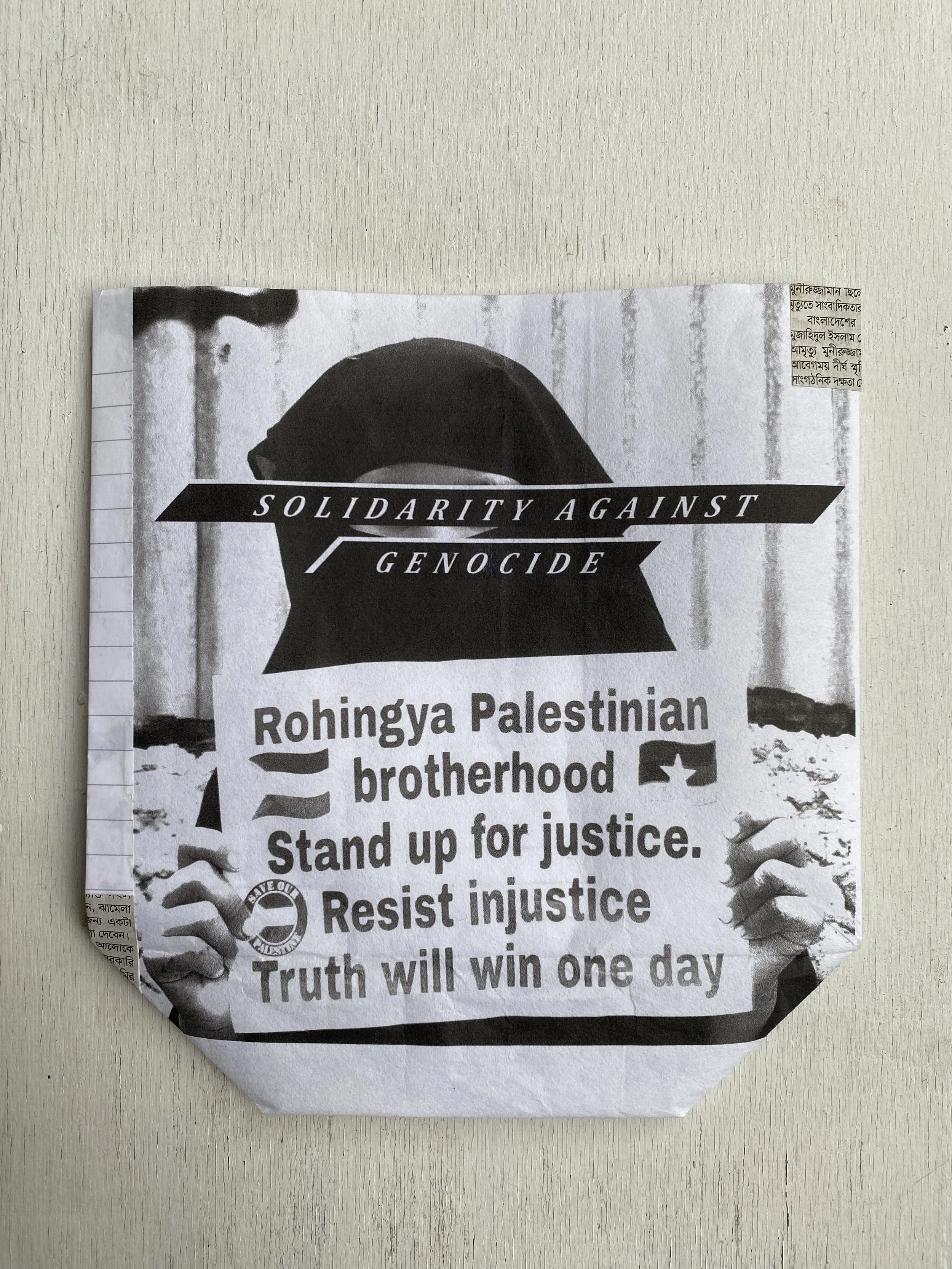T U R B I N E B A G H
Turbine Bagh is a UK based platform for political art and activism, focusing on human rights in India and Bangladesh and campaigns for political prisoners. Connecting with international struggles from BLM to Palestine, it began in 2019 with the humble and familiar object of the street samosa packet, and it continues. In 2021 Sofia Karim was a finalist for the Jameel Prize for the Turbine Bagh project.
Samosa packets made and designed by Sofia Karim using photographs by Ishan Tankha & Javed Sultan
In January 2020 Sofia Karim, collaborating with activists, initiated Turbine Bagh - a joint artists’ movement and platform for political art and activism.
India was in the grip of mass protests sparked by anti-Muslim citizenship laws. The Turbine Bagh movement emerged around a protest planned for the Turbine Hall at Tate Modern. ‘Turbine Bagh’ is a reference to Shaheen Bagh, the women-led protest in Delhi which was the epicentre of the resistance. The word ‘bagh’ means garden. For one day we would make the civic space of the Turbine Hall our ‘garden’, a space for peaceful dissent in solidarity with Shaheen Bagh.
Led mainly (but not only) by Muslim women, Shaheen Bagh challenged patriarchy but also western stereotypes of the ‘Muslim woman’. It was the largest women's resistance movement of our time. Yet few in the UK seem to know about it. The Turbine Hall protest was postponed due to COVID-19, but the movement continued.
“Turbine Bagh exists to raise awareness of what we face in India and Bangladesh today and to enact change. Our artistic endeavour extends to include the UK, Europe and beyond, addressing racism, social injustice, imperialism and arms profiteering. We need to think, to challenge, to contest.” - Sofia Karim, 2021
Follow Instagram @turbinebagh_art
1. Turbine Bagh is a joint artists’ movement against fascism and authoritarianism, focusing on India and Bangladesh and connecting with international struggles from BLM to Palestine. It was built around a peaceful protest that was due to be held in the Turbine Hall of Tate Modern museum, London. The event was postponed due to COVID-19, but the movement continues. (Samosa packets made and designed by Sofia Karim using photographs by Robert Gerhardt and John Trotter)
Background
Events in India are the latest wave of a hard-line Hindu nationalist agenda and a wider project to create a Hindu nation based on Brahmanical Hindutva ideology. We are now at a precipice. The world’s largest secular democracy has turned into a fascist, Hindu supremacist state with relative ease. That is ominous and should be a lesson to the world.
The Hindutva project has been unfolding for many years prior to these citizenship laws. Kashmir - its autonomous status revoked by the Indian government in August 2019 - has become a prison, resembling occupied Palestine. The detention camps in Assam are not being built for nothing. The president of Genocide Watch, Gregory Stanton, said in December 2019:
“The persecution of Muslims in Assam and Kashmir is the stage just before genocide. The next stage is extermination—that’s what we call a genocide.”
Home Minister Amit Shah calls Bangladeshi illegal immigrants “termites’’ and has vowed to “pick up infiltrators one by one and throw them into the Bay of Bengal.”
In February 2020 a pogrom against Muslims took place in Delhi, coinciding with Trump’s visit. At the ‘Namaste Trump’ rally crowds wore Trump and Modi masks. In his speech to the masses Trump endorsed the Modi regime and declared fundamentalist Islam to be the common enemy. The next day as the two leaders dined, Hindu supremacist mobs burned citizens alive, identified Muslim men by circumcision, and desecrated mosques while police stood by. Some Muslims fought back.
In May 2019 UK Home Secretary Priti Patel congratulated 'our dear friend’ Modi on his election victory. In October 2019, former leader Tony Blair who waged a War on Terror to “free” the world of religious fundamentalism, met Modi in Delhi with other architects of the Iraq war.
Things worsened under COVID-19 lockdown with mass arrests of intellectuals, students, and activists. Police brutality is normalised.
2. The story of the samosa packet movement starts in February 2018: I bought some samosa (‘shingara’ in Bangla) on the streets of Dhaka, Bangladesh. The packet intrigued me. It was made from waste print outs of court lists; cases between citizens and the state.
3. A few months later my uncle, photographer Shahidul Alam, was jailed by the government of Bangladesh. I staged 2 protest exhibitions at Tate Modern, Turbine Hall and began making my own samosa packets for the Free Shahidul campaign. (Photo by Suvra Kanti Das, August 2018)
4. When the India protests broke out I joined U.K. activists. To support the resistance we planned a joint artists’ demonstration at Tate Modern. We would sing protest songs around a rice circle in the Turbine Hall. Turbine Bagh was inspired by Shaheen Bagh, the women-led epicentre of the resistance in India.
5. We invited artists, writers, poets and thinkers from across the world to create Turbine Bagh samosa packets. They would be displayed in the rice circle, then sent to Shaheen Bagh, where the food was said to be excellent.
6. Samosas being shared at Shaheen Bagh. (Samosa packet designed and made by Sofia Karim using photograph by Javed Sultan).
7. Many began to contribute. The packets were printed on waste paper. (Rohingya Solidarity With Palestine packet made by Sofia Karim using photograph by Abul Kalam)
8. They came from countries including Nepal, Lebanon, UK, USA, Singapore, Mexico, Bangladesh and India. (Samosa packets made and designed by Sofia Karim featuring photographs from Jagaran Media Center/Nepal Picture Library)
9. We wanted to raise awareness. Shaheen Bagh is the largest women’s resistance movement of our time, yet many in the UK know little or nothing about it. (Shaheen Bagh, Ihtijaj packet made and designed by Sofia Karim using photograph & graphics by Ali Monis Naqvi)
10. Led (mainly, but not only) by Muslim women, the resistance in India challenges patriarchy, but it also challenges western stereotypes. (Samosa packet made and designed by Sofia Karim featuring artwork by Saba Hasan)
11. India’s non-violent, civil rights resistance, which draws together diverse faiths and social backgrounds, should be an inspiration to us all. (Samosa packet made and designed by Sofia Karim featuring photograph by Shuchi Kapoor of the Dalit protest in Una in 2016.)
12. Turbine Bagh became a movement.Though grassroots in spirit, it gained attention from some unexpected names. Sharon Stone! Artists Anish Kapoor, Zehra Dogan, Arundhati Roy, Akram Khan, Vijay Prashad and Amitav Ghosh also lent support. (Image from Sharon Stone Instagram).
13. Artists began making their own packets, in Kashmir, Singapore, New York, London and Delhi. One of the packets connected us to case of missing journalist Kajol in Bangladesh, and Turbine Bagh artists began to help the #whereiskajol campaign. The movement had reached beyond museum walls. (Packets by @trappedingeopolitics, Lipeng Law, Sadie Bridger, Lylah Sanderson)
14. In 2020 we campaigned for the release of Rohnigya photographer Abul Kalam who had been jailed by the government of Bangladesh. Since his release he continues to send us photos from the Cox's Bazar Rohingya refugee camp. (Rohingya Solidarity With Palestine packet made by Sofia Karim using photograph by Abul Kalam).
Shahidul Alam, Arles, 2023 - Photo courtesy of Editions JOJO.















